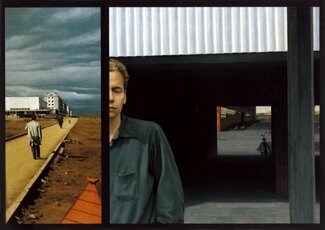


OLA BILLGREN - A Painting Retrospective.May 14 - August 4, 1991.Curator: Lars Nittve
" After an initial phase of romantic-expressive painting, in 1963 Ola Billgren (b. 1940) started forcing his way deeper and deeper into a "realistic" figuration with an increasingly complicated relationship between model and representation. His works evidence an early insight into the paradoxical (but fundamental) historicism of modernism and also an endeavour to break away from a sentimental humanism. An "ahuman" way of seeing inspired by the roman nouveau and above all by Alain Robbe-Grillet, finds expression in a most unromantic crossing between Pop, photo realism, Magritte, Vermeer and Hopper. The canvases seemed tinged by a somewhat voyerist excitement in the presence of a "reality" which only seems to appear like a shadow on an impermeable surface; like a reproduction at one remove, or like a reflection in a windowpane, filtered through the screen of the Venetian blind. It may be argued that even in the '60s Ola Billgren gave expression to essentially postmodern aesthetics, both in his paintings and his writings. An obvious example is the painting Vigseln (The Marriage) from 1970, whose model was taken from a Nazi German publication. The uniformed man slips a gas mask on to the woman's hands, "to have and to hold". A cold brownish light spreads over the hairless faces. In its insoluble conflict between tender love scene and obscure violence - what are we actually witnessing? - this work is reminiscent of Laurie Anderson's and to an even greater degree, of Robert Longo's threatening allegories of the unreadability of our systems of signs from the early '80s. In spite of their complexity, Ola Billgren's Neo-realist work seems almost didactic in the light of his "romantic" (the quotation marks are particualry necessary here) paintings of the '80s. During the previous decade a change seems to have taken place which is parallell to the one in philosophically based criticism. The sixties with their ideological criticism and "demystification" (which is now, as Roland Barthes pointed out, part of doxa) give way to the insidiously subversive strategies of post-structuralist deconstruction. On the way Billgren has the time to try a "sincere" romantic stance with a touch of bohemia and also a literary investigating historical manner of painting in the spirit of Michel Foucault. The manifold exploration of ideas and styles from the '70s are summed up in the series entitled Vinterdagar (Winter Days) from 1979-80 which was exhibited when Ola Billgren shared the Nordic Pavillion at the Venice Biennial with Jan Håfström 1980. In the "romantic" landscapes of the '80s with their air of shimmering nebulous clouds of colour and their spatial ambiguities, there is a recurring feature, an opening in the terrain, as if between columns of cypresses where, à la Poussin, the trees stand out as stoic actors while at the same time framing the lowered horizon, giving the "endless" space a contradictory scenic quality. It is a strict composition which, without ceasing to be romantic, paradoxically enough is completely classical as well. In all its melancholy seductiveness and its back flow of introspection, this painting aims at peeling off the cosmetics that cover up the split in the romantic aesthetic system. This aim is more overt in Ola Billgren's graphical series 19 Romantiska Landskap (19 Romantic Landscapes), 1983. The lithographs are based on photographically treated collages made out of reproductions of other pictures, cut out or torn from newspapers, weeklies, and fashion magazines, from travel guides and books on art history. There are layers upon layers of cultural deposits, covered in seductive, "unnatural" colours. There is no connection between the Romantic Landscapes and the romantic attitude to landscape where, according to the tenets, the creating artist and nature are one, beyond intellect and language. Instead of pantheistic unity we encounter the fragments in a collage; instead of immediacy there is the distance of technology. And yet they reek with "romanticism". The principle of the collage is often evidenced in the painting as well, partly as Billgren often sketches in the montage technique, partly as his virtuoso handling of the various layers of paint is based on his linguistic, collage-related practice. Another factor is his manner of using the space at his disposal in a specific exhibition. It is often given the caracter of a neutral surface where the paintings are combined in antithetical or serial constellations - very much like the components of a collage. The installations at Ibid II in 1983 and at Galerie Asbaek, Copenhagen, 1984, were perfect examples of this. A cool, distant manner of painting was juxtaposed to violent, half transparent brush work, saturated with expressionism. Amorphous, hot and yet damp clouds of colours confronted lyrically cool, serenely shimmering surfaces in the tradition of the late Monet. All the paintings had the same large, square format. The common format emphasized the differences, playing the paintings off against each other: an apparently "honest" canvas was implacably falsified by its neighbour. Any expectations that they, in the spirit of modernism, would reveal themselves as scenes where the self enacted its various roles were frustrated. Ola Billgren is today a proponent of an out-and-out postmodernist deconstruction, a seductive agent provocateur in the Romantic landscape. " |

CURRENT EXHIBITIONS | UPCOMING EXHIBITIONS | PREVIOUS EXHIBITIONS
ABOUT ROOSEUM | EVENTS | BOOKSHOP | GUESTBOOK | LINKS | INDEX
![]()
Copyright 1996 the Rooseum, the artists,the authors & the photographers.
All rights reserved. No portion of this document may be reproduced,
copied or in anyway reused without permission from Rooseum.